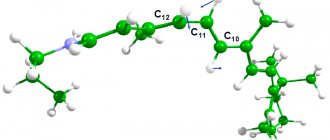Types of sensory disorders
Violations are divided into several subgroups: decreased sensitivity, increased sensitivity.
Decreased sensitivity
Decreased sensitivity is divided into three pathologies: analgesia, hypersthesia and thermaneesthesia. Analgesia is the disappearance of sensitivity to pain, a symptom of many diseases and injuries of the nervous system. Hypesthesia is a decrease in tactile sensitivity. Thermaneesthesia is the loss of perception of cold and heat.
Increased sensitivity
Increased sensitivity includes hyperalgesia, hyperesthesia and hyperpathy. Hyperalgesia is a pathologically high sensitivity to pain. Hyperesthesia is an increase in tactile sensitivity. Hyperpathy is the occurrence of a strong feeling of unpleasantness when exposed to a stimulus. The sensation often persists for a long time even after the stimulus has stopped.
Back Next
This chapter deals only with sensory disturbances associated with mental disorders.
and not caused by pathology of the sensory organs or damage to the primary cortical analyzers.
Not every stimulus causes a sensation. The minimum magnitude (strength) of the stimulus at which sensation first occurs is called the threshold of sensation (more precisely, the lower absolute threshold of sensation
), or
sensitivity threshold .
Normally, the sensation of ordinary stimuli is located in the zone of physiological and psychological comfort; subthreshold stimuli do not cause any sensations, but at the same time, a person has sufficient sensitivity to perceive stronger stimuli, which allow him to receive information about the external and internal world. Hyperesthesia - increased sensitivity to stimuli (reduced threshold of sensations).
Sensations of ordinary strength acquire an unnaturally sharp character, for example, the light becomes unbearably bright, sounds become deafeningly loud, smells become unbearably pungent. In addition, the attention of patients begins to be attracted by extremely weak stimuli that were not previously perceived (were subthreshold). For example, when unsuccessfully trying to fall asleep, a person begins to be disturbed by the sound of a working refrigerator, the noise of dripping water, neighbors walking above, uncomfortable clothes, and bed linen. In some cases, they are more concerned about the course of their own physiological processes: the beating of their own heart, intestinal peristalsis, etc. People with hyperesthesia are burdened by such enhanced sensations, sometimes react to them with irritation.
Hyperesthesia can be general or partial (detected in one or more sense organs). Hyperalgesia - increased pain sensitivity.
Hyperesthesia is most often observed:
- for asthenic syndrome (see below)
- in anxiety states (hyperesthesia here reflects fear of an impending threat, the desire to identify this threat as early as possible and try to avoid it, therefore all a person’s feelings in these states are heightened)
- in various conditions accompanied by hypochondriacal experiences, in these cases there may be an increase in interoceptive (from internal organs) sensations - visceral hyperesthesia, i.e. the patient “listens” to everything that happens in his body, pays attention to the slightest sensations that he had previously ignored
- with masked (somatized) depression (visceral hyperesthesia)
- with delirious stupefaction (may be noticeable already in the initial stages)
- hyperesthesia to odors is often described in pregnant women
Intolerance to any inconvenience, which is a consequence of hyperesthesia, is often observed in many people with various somatic diseases (hyperesthesia is formed as part of the asthenic syndrome, which occurs due to exhaustion due to somatic illness). Such patients express many complaints, including about the conditions of stay in a medical institution, roommates, “rude”, inattentive doctors, nurses, etc. If these conditions are misunderstood, the medical staff develops a negative reaction to such complaints (“whims”) of patients , which further traumatizes patients and causes dissatisfaction with the quality of treatment.
During medical procedures, it is necessary to take into account that the level of sensitivity in people can vary significantly, and what one patient can “withstand without blinking an eye”, in another patient, or in the same patient at another time and in a different condition, may cause quite strong pain. Anxious anticipation of unpleasant manipulations increases sensitivity to irritants , and a calming conversation with a doctor reduces sensitivity, in which all stages of the upcoming treatment will be explained to the patient and unnecessary fears will be removed (since in such situations, the patient’s anxiety is most caused by a lack of information, similar to how afraid we can be to walk through an unfamiliar dark park at night: we listen to the rustling of leaves, examine every shadow (is there a criminal lurking there?); whereas in daylight, a walk through the same park would most likely give us completely different experiences emotional experiences).
Painful sensations caused by any somatic pathology are experienced by patients with different intensities, also depending on external conditions. So, often during the day a patient, for example with beginning appendicitis or pulpitis, carries out his daily activities, communicates with the people around him, all this distracts him from pain, but in the evening or at night, left alone with his pain, he finally “ notices its expression. In addition, anxiety about one’s condition is often added, which further intensifies the experience of pain. All this leads to the fact that a significant part of patients seek medical help in the evening and night hours, when medical institutions have only a duty shift, and not during the day, when a full staff of doctors is present.
Hypoesthesia is decreased sensitivity to stimuli (the threshold of sensations is increased).
Ordinary stimuli are felt less bright (hot is felt warm, bright light is dull, a loud sound is quiet, food is tasteless, etc.), weak stimuli are not perceived at all, in certain cases only stimuli of great strength can penetrate consciousness.
Anesthesia is a lack of sensitivity to stimuli. Analgesia is insensitivity to pain.
Psychopathological conditions in which hypoesthesia or anesthesia may be observed:
- depression (patient complaints are typical: the colors of the world are “faded, gray”, food is “tasteless, bland”, etc. This reflects a change in the emotional component of the perception process)
- states of switching off consciousness
- catatonic syndrome
- a state of strong affect (i.e. strong emotional experience, for example, among soldiers during battle)
- deep stages of hypnosis
- dissociative (hysterical) disorders
Back Next
To see comments you must register
Hyperesthesia (increased tooth sensitivity) - symptoms and treatment
Treatment of hyperesthesia is aimed at reducing the speed of fluid flow in the dentinal tubules. This can be achieved in the following ways:
- blockage of enamel micropores with the help of desensitizers - drugs that reduce tooth sensitivity;
- reducing the size of micropores using mineralizing agents, for example, gels with a high content of fluoride and calcium. These include gels ROCS Medical Minerals, GC Tooth Mousse;
- closing or narrowing of dentinal tubules using a laser [14];
- preparation and filling of teeth for carious lesions;
- surgery on the gum when it recedes as a result of periodontal disease;
- correction of the bite.
In 1935, dentist L. Grossman identified the main properties of an ideal remedy for combating hyperesthesia [12]. In his opinion, it should act quickly and be effective for a long time, not irritate the pulp, not provoke pain and not change the color of the teeth. There are quite a lot of such drugs now. Desensitizing agents (reducing tooth sensitivity) are produced in the form of gel, toothpaste, rinse, varnish, etc. Toothpastes are most often used.
For mild hyperesthesia , as a rule, applications of various solutions are sufficient.
The drug Remodent in the form of a 3% aqueous solution for applications is applied to areas of hyperesthesia for 15-20 minutes. For the course of treatment to be effective, it is necessary to make 8-28 such applications (one 2 times a week) until a positive result is achieved. Sometimes a 3% solution of remodent is used as a rinse (4 times a week). The full course includes about 40 procedures.
Strontium chloride is used in the form of a 25% aqueous solution and 75% paste. When rubbing the paste, stable compounds of strontium appear with the hard tissue of the tooth. This remedy is a good prevention of hyperesthesia after tooth preparation and removal of dental plaque.
To eliminate hyperesthesia, a 30% aqueous solution of zinc chloride is also used. After this, an application is carried out with a 10% solution of potassium ferrocyanide. It seals the tubules with the resulting sediment. The duration of the applications is one minute. The use of a paste containing alkalis is also indicated: sodium bicarbonate, sodium carbonate, potassium, magnesium. It attracts dentinal fluid, which is contained in the micropores of the enamel, and reduces tooth sensitivity.
A modern treatment for hyperesthesia is bifluoride-12, a special colorless varnish containing fluoride, and fluocal, a dental gel containing sodium fluoride. They are carefully applied to the teeth with a brush or foam swab. Both products create a coating that saturates the enamel and dentin with fluoride ions, which leads to a decrease in sensitivity. Fluocal can also be used in the form of an application solution. Typically, a course of treatment with such applications includes only 2-3 procedures. Varnish is usually used as an auxiliary method that enhances the effect of the main drug [15].
Treatment of hyperesthesia with laser has been shown to be the preferred treatment method. It is aimed at narrowing the dentin tubules by combining the proteins of the dentin fluid, partially melting the hard tissues and relaxing the internal nerve receptors. Laser therapy has no side effects [15].
Treatment of generalized hyperesthesia is aimed at eliminating the cause of the disease, so it not only relieves symptoms, but also affects the course of the disease. Treatment must be comprehensive. In addition to treating the main cause of hyperesthesia, it is necessary to restore the mineral composition of enamel and dentin, and normalize the content of phosphorus and calcium in the body. For this purpose, calcium glycerophosphate, clamine or phytolon, as well as multivitamin preparations are prescribed. Taking phosphorus-calcium drugs throughout the course of treatment provides a good prognosis. Otherwise, restoration of normal sensitivity will take a long time.
To eliminate pain at the beginning of treatment, in addition to using toothpaste with phosphate, electrophoresis with a 2.5% solution of calcium glycerophosphate is required. The course of such physiotherapy is 10 sessions. In case of hyperesthesia against the background of impaired neurological status, the use of a galvanic collar according to Shcherbak is indicated (also at least 10 sessions).
Studies have shown that the effect of complex treatment of hyperesthesia occurs quickly and lasts for quite a long time. The content of phosphate and calcium in the dental tissues increases, the level of calcium and phosphate in the blood normalizes.
During the treatment of hyperesthesia of any degree it is necessary:
- select personal hygiene products;
- control bad habits (do not bite nails, pencils);
- adjust your diet (exclude soda, sticky sweets, consume vegetables, fruits and dairy products more often);
- wear a mouth guard at night (for bruxism) [14].
Should hypersensitivity be treated?
If such symptoms occur, a psychiatrist, psychotherapist (psychotherapist) should be very careful about collecting more detailed information, since there is a high probability of establishing an erroneous opinion, which will lead to the choice of the wrong treatment tactics for the patient, which means that treatment will not bring a person the expected relief from his mental state.
Sensitivity, or special, increased sensitivity, can be observed in various mental disorders, for example:
- Characterological features of personality development (personality pathology).
- Stressful conditions.
- Anxiety disorders.
- Various depressions.
- Neuroses.
- Organic diseases of the brain.
- Toxic brain damage.
- Endogenous mental disorders.
To accurately determine the true condition and establish a complete and accurate diagnosis, the correct selection of treatment for a mental disorder, a psychotherapist is obliged to conduct a differential diagnosis.
Interpersonal sensitivity
It is determined by feelings of personal inadequacy and inferiority, especially when compared with others, when a person begins to evaluate himself in comparison with other people. Self-judgment, a feeling of anxiety and significant discomfort in the process of interpersonal interaction, which is felt by a person in the form of a decrease in the quality of life. In addition, the sense of awareness of one’s own “I” and negative expectations regarding interpersonal interaction and any interpersonal communications very often intensify.
Sensitivity is a personality trait consisting of increased sensitivity and vulnerability, self-doubt, increased conscientiousness and a tendency to doubt, to fixate one’s experiences.
Complaints with sensitivity, hypersensitivity
- Special sensitivity
- Dissatisfaction with others
- They don't understand you
- Feeling that people are unfriendly or don't like you
- Feeling that you are worse than others
- Excessive shyness or inhibition when interacting with others
- Feeling awkward when people look at you
- That your feelings are easily hurt
Sensitive (sensitive) - A person with increased sensitivity, mentally easily vulnerable.
Sensitive period - The period in a child’s life in which motor ability is acquired or developed. It would be more precise to formulate this period when the child is mentally mature enough to learn certain functions. Usually the environment in which the child lives and the people around him provide him with numerous occasions for exercise, corresponding to his needs at the moment in which they become tangible. When this does not happen, the possibility of natural assimilation is lost. Those. the period of special sensitivity is lost. In such cases, children may almost completely lose the ability to later acquire human language and human-appropriate behavior (Critical period in child development).
Increased human sensitivity
Sensitive aura - expressed in sensations of paresthesia, pain, cardiac and gastric dysesthesia, most often in the form of “lightheadedness” rising from the stomach to the throat, in attacks of suffocation, etc. Observed in brain pathology.
Paresthesia is a type of sensitivity disorder characterized by sensations of numbness, tingling, and crawling sensations. False feelings.
Dysesthesia, a more general concept that also includes a distorted perception of external stimuli, can often manifest itself in the form of “irritable legs” syndrome. Syndrome of irritation, burning, painful nature. It can often manifest itself in the form of allergic reactions.
Delusion of a sensitive attitude - Delusion associated with the real or imaginary physical or moral inferiority of the patient, physical or mental disabilities, indecent acts committed in the past. Often the patient is convinced that some action, often not good, is known to others and is the basis for hints and discussions. His increased sensitivity worsens even more.
Sensitive delusions of relationships Kretschmer - Psychogenically caused paranoid delusions of relationships, in the occurrence of which the role of a person’s increased sensitivity, his accentuated affectivity and constitutional predisposition is significant. Thus, sensitive delusions of attitude are, as it were, derived from the character of the individual and the emotional state of the patient.
Interpersonal sensitivity, or special sensitivity, can manifest itself as short-term states, for example, with severe grief, disappointment or nervous tension: “Everyone is against me,” “The whole world is up in arms against me.” These sensations can also be frequent or constant. It is not uncommon for sensitive thinking to subjugate a person’s behavior and hinder his social adaptation.










